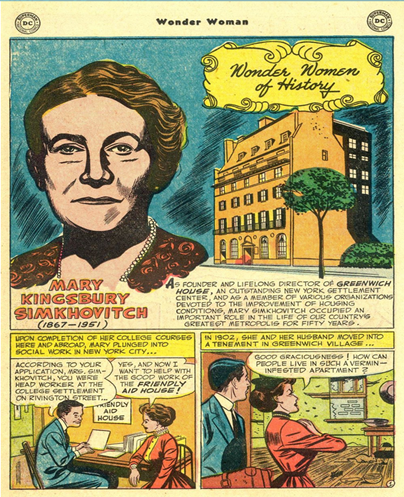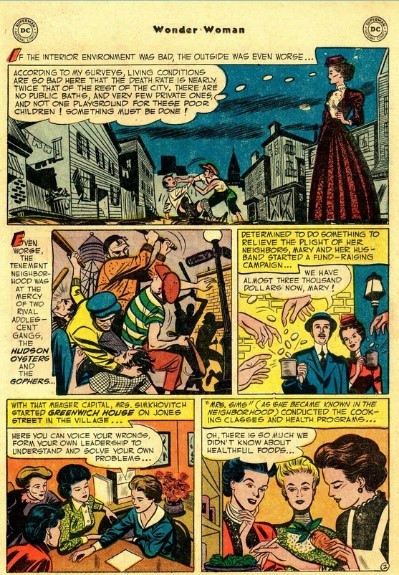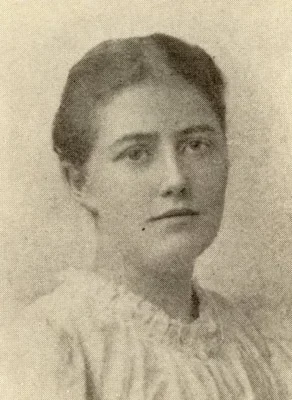Notable Companion: Mary Kingsbury Simkhovitch
Notable Companion Mary Kingsbury Simkhovitch
Mary Melinda Kingsbury was the daughter of a Boston land baron and grew up with privilege. She and her mother sailed to Germany in the Summer of 1895 where Mary was to take classes at the University of Berlin after having earned her undergraduate degree from Boston University...
OUR FEATURED PARADISE CHAPTER COMPANION:
Mary Kingsbury Simkhovitch
Born, September 8, 1867, in Chestnut Hill, Boston.
Died, November 15, 1951, in New York City.
Admitted into the SCHC: 1915
Wonder Woman #55

Figure 1: The Founder and Director of Greenwich House in Issue No. 55 of DC Comics honoring Mary Simkhovitch as a Superhero 1952, (Courtesy of Vine Comics.)
A young married couple stood in front of a neglected three-story heap located at 26 Jones Street, aka “The Street of Forty Thieves,” in Greenwich Village. Rats and other vermin were very evident. Windows were smashed and there was no power coming into the building. But they loved it and they loved what it could become. This idealistic couple couldn’t have picked a worse place in New York City to launch their impossibly ambitious socio-economic model, but they had worked too hard to come this far.
Mary Melinda Kingsbury was the daughter of a Boston land baron and grew up with privilege. She and her mother sailed to Germany in the Summer of 1895 where Mary was to take classes at the University of Berlin after having earned her undergraduate degree from Boston University. While pursuing her bachelor’s degree, she had spent many hours volunteering in Boston’s churches, nursing homes and tenements assisting the poor. Notably, Mary had worked with Helen Dudley and Vida Scudder at the Denison Settlement House in Boston’s South End. The experience convinced Mary that there was no fairness in the Capitalist model for society. Wealth had to be spread around more fairly. It was in Berlin that Mary met a young man who agreed with her convictions about economic fairness for all and in short order it was a romance. They just had to tell Mary’s mother.* That was not going to be easy.
Mrs. Kingsbury was knocked back on the heels of her high button boots when the sweethearts burst through the door announcing that they would marry and change the world together. Not so fast, advised mother, they should wait. Dutifully, they obeyed Mother.
In the Summer of 1896, Mary travelled to London with her friend Emily Greene Balch (a future Nobel Peace Prize winner) to attend the International Socialist Trade Union Congress, which further inspired Mary to end poverty.
At last, in 1899, church bells chimed for Mary and Vladimir. But, to heck with romance, there was social injustice to vanquish. The couple settled in New York City to work for the Friendly Aid Society. Vladimir would secure a teaching position at Columbia University to provide a stable income. He also provided a fair amount of controversy. Dr. Simkhovitch was well known for creating an atmosphere of constant feuding with his fellow professors.
There were two realities in Greenwich Village. Days teemed with immigrants and locals, bustling between menial jobs and open-air markets, before returning home to dangerously overcrowded tenement housing. At night, it was Hell with the lid off, with gang activity that was too dangerous to deal with. Mary and Vladimir raised the money to buy the Jones Street eyesore by walking the streets of Manhattan carrying slotted tin cans asking people for spare change because, according to Vladimir, their savings account was “pathetically low.” Like-minded friends joined them in the enterprise and eventually they raised $3,000. The first task was to evict the squatters made up of anti-government anarchists and two local street gangs, the Hudson Street Dusters, and the Gophers, which they did without making enemies of them. Poverty was the engine that drove the gangs.
It took three years and a lot of elbow grease to transform the former flophouse into a warm home for poor immigrants and locals who were looking for a better life. The doors of Greenwich House officially opened on Thanksgiving Day, 1902, and grew vigorously in the decades that followed. In 1905, the settlement house began to offer classes in the trades, including a pottery school, and later, a music school and a theatrical stage. Mary was relentless in her search for volunteers who could teach life skills to poor young women, carpentry and other practical skills to young men, and English language classes to immigrants who could only speak their native tongue. The work was endless. Mary joined the controversial “Committee of 14,” which was hell bent on eradicating prostitution, one of the only ways some women could escape penury.
The Simkhovitch’s worked with neighborhood toughs, rascals, and scallywags, leading them to more creative and fulfilling activities to advance their learning and growth. In time, they came to know nearly all the neighborhood’s children and families by name.
Mary became particularly friendly with a young volunteer who wore great big bows atop her long hair. Her name was Eleanor Roosevelt. When Mrs. Roosevelt became America’s first lady, she was a formidable advocate for settlement houses across the country. Both she and New York City Mayor, Fiorello LaGuardia, ensured that more affordable housing would be built for the working poor. It was not always a happy partnership. They argued over it all. Both Roosevelt and LaGuardia thought housing was enough and that job training and other programs could be started separately with the help of the federal government. Mary dug in her heels. She wanted every settlement house to reflect the Greenwich House model of housing, job training, healthcare and educational opportunities in one place for anyone willing to apply themselves, a very American ideal.
With the success of Greenwich House came the chance to tack on more real estate to the organization. A new building at 27 Barrow Street was purchased, where the Simkhovitch family would live for forty years within the thriving community. Mary and Vladimir’s children Helena and Stephen joined in the work which continued until 1946, when Mary decided to reduce her hours at the helm. Retiring didn’t mean Greenwich House had to close. It is a thriving organization to this day!
There were many honors and initiatives in store for our great Companion. Mary became the Vice President of the New York City Housing Authority and a member of The New York Housing Commission. Every morning, before her long days started, she attended Holy Communion at St. Luke’s Chapel. In 1915, Mary became a Companion. One wonders when she had the time. She was a regular at Chapter meetings, but did not attend Adelynrood as much as she would have liked. She had too many obligations to work and family; however, she had someone read a short paper on social justice issues at the Annual Meeting for many years.
In November of 1946, a grand afternoon tea was held at Greenwich House to honor Mary. Mayor LaGuardia arrived ten minutes early. He loved tea sandwiches because he could stuff them into his suit jacket pockets, whispering to an aide, “Hell, I gotta’ go to three other places today.” Telegrams from politicians and celebrities streamed in, each read aloud as it arrived. A former Greenwich House tenant sent his best wishes from Hollywood. The room went wild with applause when a message from Kirk Douglas was read.
Retirement was not in Mary’s DNA, although she would turn the daily direction of Greenwich House over to someone else and work a little less. With Vladimir, she raised exotic pheasants at their vacation home in Robbinston, Maine. With more time Mary would write articles and books. Her best-known work, “Here is God’s Plenty” was published in 1949.

Figure 2: A depiction of unsavory life in Greenwich Village and Mary and Vladimir’s efforts to change the cycle of poverty. (Courtesy of Vine Comics)
A long life and a lifetime’s work came to end on November 15, 1951, when Mary died in New York City. She was 84 years old. Her funeral service was spectacular, attended by many who had lived and worked at Greenwich House, along with gaggles of celebrities and politicians. More than five hundred elementary school children stood across the street from St. Luke’s during the solemn service. Afterwards, a woman asked a little boy if he knew Mrs. Simkhovitch. He replied, “We all knew her, and she knew us.” Mary was buried in Brewer Cemetery in Robbinston. She and Vladimir rest side by side.
In 1952, DC Comics honored Mary as a Super Hero and A Wonder Woman of History, Issue #55.
*There is one account in an article, the source of which is unidentifiable, stating that Mary met Vladimir at Columbia University in 1896 and not Berlin Germany. The majority of sources for this article state that the couple met in Berlin.
C.D.P February 14, 2023






